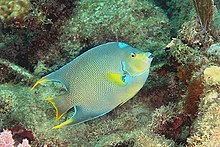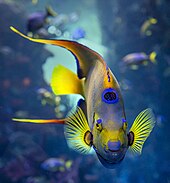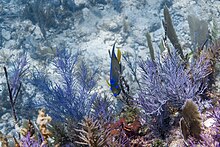Queen angelfish
| Queen angelfish | |
|---|---|

| |
| Adult queen angelfish | |
| Scientific classification | |
| Kingdom: | Animalia |
| Phylum: | Chordata |
| Class: | Actinopterygii |
| Order: | Perciformes |
| Family: | Pomacanthidae |
| Genus: | Holacanthus |
| Species: | H. ciliaris
|
| Binomial name | |
| Holacanthus ciliaris | |
| Synonyms[2] | |
| |
The queen angelfish (Holacanthus ciliaris), also known as the blue angelfish, golden angelfish or yellow angelfish, is a species of marine angelfish in the family of Pomacanthidae that are found in the western Atlantic Ocean. It is a benthic (ocean floor), warm-water species that lives in coral reefs. It is recognized by its blue and yellow coloration and a distinctive spot or "crown" on its forehead. This crown distinguishes it from the closely related and similar looking Bermuda blue angelfish (Holacanthus bermudensis), with which it overlaps in range and can interbreed.
Adult queen angelfish are very selective feeders and primarily eat sponges. Their social structure consists of harems which include of one male and up to four females. They live within a territory, where the females forage separately and are tended to by the male. Breeding in the species correlates with the full moon. The female ascends the water column as the male swims below her with his snout touching her vent. Juveniles of the species have different coloration than adults and act as cleaner fish.
The queen angelfish is popular in the aquarium trade and has been a particularly common exported species in Brazil. In 2010, the queen angelfish was assessed as least concern by the International Union for Conservation of Nature (IUCN) as wild population appeared to be stable.
Taxonomy[]
The queen angelfish was first formally described as Chaetodon ciliaris in 1758 in the 10th edition of his Systema Naturae by Carl Linnaeus with the type locality given as the "Western Atlantic/Caribbean".[3] The genus name Holacanthus was coined by French naturalist Bernard Germain de Lacépède in 1802.[4] and is derived from the Ancient Greek words "holos" (full) and "akantha" (thorn).[2] Its specific name ciliaris means "fringed", a reference to its squamis ciliatis which means "ciliate scales".[5] Other common names for the species include "blue angelfish", "golden angelfish" and "yellow angelfish".[6]
Marine angelfish of the genus Holacanthus likely originated between 10.2 and 7.6 mya. The most basal species is the Guinean angelfish (Holacanthus africanus) off the coast of West Africa, indicating that the lineage colonized the Atlantic from the Indian Ocean.[7] The closure of the Isthmus of Panama 3.5–3.1 mya led to the splitting off of the Tropical Eastern Pacific species.[8] The closest relative and sister species of the queen angelfish is the sympatric and similar Bermuda blue angelfish (H. bermudensis), which it split from around 1.5 mya.[7][8] They are known to interbreed, producing the hybrid known as the Townsend angelfish,[9] which has features intermediate between the parent species.[10] The Townsend angelfish is fertile and will bred both with other hybrids and with the two parent species.[11]
The following cladogram is based on molecular evidence:[7][8]

| Holacanthus |
| ||||||||||||||||||||||||||||||||||||
Description[]

The queen angelfish has a deep, compressed oval-shaped body with a short, blunt snout and a small mouth containing bristle-like teeth.[12] The dorsal fin contains 14 spines and 19–21 soft rays while the anal fin has 3 spines and 20–21 soft rays.[2] This species attains a maximum total length of 45 cm (18 in) and weigh 1,600 g (56 oz).[2][6] Males may be larger than females.[13][14]
The species' distinctive coloration has been described like it was "painted by someone trying to use all the colors in a new paint set". It has blue-green flank (side) scales with yellow edges while the tail and paired fins are bright-yellow and the anal fins are orange-yellow. The back of the dorsal fin is tipped in orange-yellow while the pectoral fins have large blue spots at the base.[13] On the forehead, above and behind the eyes, is an ocellated (eye-like) spot or "crown" with an electric blue ring surrounding a cobalt blue center with electric blue spots.[2][13] This crown is the main feature distinguishing the species from the Bermuda blue angelfish.[6][13]

Juveniles are dark blue with bright blue vertical stripes, with the tail and pectoral fin area being yellow. Juvenile queen angelfish resemble juvenile blue angelfish, and are distinguished by more curved vertical stripes.[6] Growing juveniles develop transitional patterns as they reach their adult coloration.[13]
Off the coast of the Saint Peter and Saint Paul Archipelago, Brazil, seven other color morphs have been recorded. These include a bright-orange gold morph, an all-white morph, a white morph with orange and black blotches, a bright blue morph which has a pale caudal fin, a yellow-faced bright blue morph with a pale caudal fin, a bright blue morph with both the pectorals and caudal fin yellow, and a bright blue morph with black-and-white pectoral/caudal fins and white mouth and operculum.[15] Another color morph was recorded off Dry Tortugas, Florida in 2009. This fish was mostly cobalt blue with white pectoral, pelvic and caudal fins. The snout and operculum area had mottled cobalt blue and white coloration while the dorsal and anal fins were deep yellow-orange and white.[16]
Ecology[]

Queen angelfish are found in tropical areas of the Western Atlantic Ocean. They occur from Florida south through the Caribbean Sea and Gulf of Mexico to the coast of Brazil. Its range extends as far east as Bermuda and the Saint Peter and Saint Paul Archipelago.[1] Queen angelfish are benthic[6] and live on offshore reefs among both hard and soft corals. They can be found at depths as shallow as 2 m (6 ft 7 in) to as deep as 70 m (230 ft).[17]
As adults, queen angelfish feed mainly on sponges but also consume algae, hydroids, bryozoans and tunicates.[17] Juveniles act as cleaner fish and set up cleaning stations where they pick ectoparasites off bigger fish.[6] Off St. Thomas Island and Salvador, Bahia, 90% of the diet of adults are sponges. Off the Saint Peter and Saint Paul Archipelago, more than 30 prey species may be consumed, 68% being sponges, 25% being algae, and 5% being bryozoans. Queen angelfish appear to be highly selective feeders as the proportion of prey in their diet does not match that of the benthic community they inhabit. On the species level, the angelfish of the Saint Peter and Saint Paul Archipelago prefer the less common sponges Geodia neptuni, , Clathria calla and .[18]
Lifecycle[]

Queen angelfish live in harems consisting of one male and two to four females, and within a large territory.[14] Little is known about the sexual development of the species, though they are presumed to be protogynous hermaphrodites. If a harem male disappears, the largest female may change sex.[11] During midday, the females forage separately in different locations. The male tends to each of them, rushing, circling and feeding next to them.[14] Spawning in this species occurs year round[19] and is observed within minutes of sunset and within a couple days or a week of a full moon.[14]
Angelfish spawn in pairs[13] and courtship involves the male displaying his side to the female and slightly flicking his pectoral fins outwardly at intervals lasting a few seconds. At the beginning of spawning, the female ascends the water column as the male swims below her with his snout touching her vent.[14] They then release their eggs and semen into the water. The female can discharge between 25 and 75 thousand eggs in an evening and up to ten million eggs in a spawning cycle.[6] After spawning, the pair separate and head for the bottom, where the female may nip and chase the male.[11]
The transparent eggs are pelagic and float in the water, hatching after 15–20 hours. The initial larvae have a large yolk sac and lack functional eyes, gut or fins but after 48 hours the yolk is absorbed and the larvae have more of a resemblance to normal fish. These larvae feed on plankton in the water column and grow rapidly. After around 3–4 weeks from hatching, when they have reached a length of 15 to 20 mm (0.6 to 0.8 in) they settle on the floor. Juveniles live alone and in territories in and around finger sponges and coral. Within these territories, they establish cleaning stations for other fish.[6]
Human interactions[]

Queen angelfish are not normally eaten nor are they commercially fished. They are captured mostly for the aquarium trade, where they are abundant and highly valued.[20] As juveniles, angelfish can be conditioned to accept typical aquarium food and hence have a higher extended survival rate than individuals taken as adults, which have a more specialized diet.[21] This species requires a certain level of water quality and lighting and proper feeding to maintain their vibrant colors. With poor husbandry, queen angelfish lose their blue colors and become yellow.[22]
Throughout the 1990s the dockside price for an individual fish averaged from US$11.16 to $17.84 in Florida. The retail price for the species may range from US$60 to $130.[20] The queen angelfish is the most frequently angelfish species exported from Brazil.[1] From 1995 to 2000, 43,730 fish were traded at Fortaleza in the northeast of the country. In 1995, the queen and French angelfish were nearly 75% of marine ornamental fish traded.[23] In 2010, the queen angelfish was assessed as least concern by the IUCN. Stating that, aside from Brazil, the species is not harvested too much in its range and the wild population appears to be stable.[1]
Specimens of queen angelfish have been caught in the eastern Adriatic Sea, off Croatia, in 2011, and in the Mediterranean Sea, off Malta, in 2020. These are likely introductions from the aquarium industry and not natural colonizations.[24] In 2015, an aquarium-introduced angelfish was caught in the Red Sea at Eilat's Coral Beach, Israel. The bacteria Photobacterium damselae piscicida was isolated from its kidney, raising concerns that it could infect native fish.[25]
References[]
- ^ a b c d Pyle, R.; Myers, R.F.; Rocha, L.A.; Craig, M.T. (2010). "Holacanthus ciliaris". IUCN Red List of Threatened Species. 2010: e.T165883A6156566. doi:10.2305/IUCN.UK.2010-4.RLTS.T165883A6156566.en. Retrieved 19 November 2021.
- ^ a b c d e Froese, Rainer and Pauly, Daniel, eds. (2019). "Holacanthus ciliaris" in FishBase. December 2019 version.
- ^ Eschmeyer, William N.; Fricke, Ron & van der Laan, Richard (eds.). "Species in the genus Holacanthus". Catalog of Fishes. California Academy of Sciences. Retrieved 21 February 2021.
- ^ "Holacanthus Lacepède, 1802". World Register of Marine Species. Retrieved November 24, 2021.
- ^ Christopher Scharpf & Kenneth J. Lazara (21 July 2020). "Order ACANTHURIFORMES (part 1): Families LOBOTIDAE, POMACANTHIDAE, DREPANEIDAE and CHAETODONTIDAE". The ETYFish Project Fish Name Etymology Database. Christopher Scharpf and Kenneth J. Lazara. Retrieved February 22, 2021.
- ^ a b c d e f g h "Holacanthus ciliaris". Discover Fish. Florida Museum. Retrieved 22 February 2021.
- ^ a b c Alva-Campbell, Y; Floeter, S. R.; Robertson, D. R; Bellwood, D. R; Bernardi, G (2010). "Molecular phylogenetics and evolution of Holacanthus angelfishes (Pomacanthidae)". Molecular Phylogenetics and Evolution. 56: 456–461. doi:10.1016/j.ympev.2010.02.014.
- ^ a b c Tariel, J; Longo, G. C; Bernardi, G (2016). "Tempo and mode of speciation in Holacanthus angelfishes based on RADseq markers". Molecular Phylogenetics and Evolution. 98: 84–88. doi:10.1016/j.ympev.2016.01.010.
- ^ Reyes-Bonilla, H; Alvarez-Filip, F; Sánchez-Alcántara, I (2010). "New records of the Townsend angelfish (Holacanthus bermudensis X H. ciliaris hybrid) and range extension of the Blue angelfish (H. bermudensis) in the Caribbean Sea". Caribbean Journal of Science. 46 (2–3): 339–345. doi:10.18475/cjos.v46i2.a24.
- ^ Feddern, H (1968). "Hybridization between the western Atlantic angelfishes, Holacanthus isabelita and H. ciliaris" (PDF). Bulletin of Marine Science. 18 (2): 351–382.
- ^ a b c Deloach, Ned; Deloach, Anne (2019). Reef Fish Behavior: Florida, Caribbean, Bahamas (2nd ed.). New World Publications. pp. 175–176, 180–181. ISBN 978-1878348685.
- ^ "Species: Holacanthus ciliaris, Blue angelfish". Shorefishes of the Greater Caribbean online information. Smithsonian Tropical Research Institute. Retrieved 22 February 2021.
- ^ a b c d e f Snyder, David B; Burgess, George H (2016). Marine Fishes of Florida. Johns Hopkins University Press. pp. 221–224. ISBN 978-1421418728.
- ^ a b c d e Moyer, J. T; Thresher, R. E; Colin, P. L (1983). "Courtship, spawning and inferred social organization of American angelfishes (Genera Pornacanthus, Holacanthus and Centropyge; Pomacanthidae)". Environmental Biology of Fishes. 9 (1): 25–39. doi:10.1007/BF00001056.
- ^ Luiz Jr, O. J (2003). "Colour Morphs in a Queen Angelfish Holacanthus ciliaris (Perciformes: Pomacanthidae) population of St. Paul's Rocks, NE Brazil". Tropical Fish Hobbyist. 51 (5): 81–90.
- ^ Feeley, M; Luiz Jr, O. J; Zurcher, N (2009). "Colour morph of a probable queen angelfish Holacanthus ciliaris from Dry Tortugas, Florida". Journal of Fish Biology. 74 (10): 2415–2421. doi:10.1111/j.1095-8649.2009.02259.x.
- ^ a b Allen, Gerald R.; Steene, Roger; Allen, Mark (1998). "A Guide to Angelfishes and Butterflyfishes". Odyssey Publishing: 206. ISBN 978-0966172010. Cite journal requires
|journal=(help) - ^ Reis, F.; Moraes, F.; Batista, D.; Villaça, R.; Aguiar, A.; Muricy, G. (2013). "Diet of the queen angelfish Holacanthus ciliaris (Pomacanthidae) in São Pedro e São Paulo Archipelago, Brazil". Journal of the Marine Biological Association of the United Kingdom. 93 (2): 453–460. doi:10.1017/S0025315412001099.
- ^ Nottingham, Mara C.; Feitosa Silva, José Roberto; de Araújo, Maria Elisabeth (2003). "Morphology and Histology of the Testicles of Queen Angelfish Holacanthus ciliaris (Linnaeus, 1758) (Teleostei: Perciformes: Pomacanthidae)". Arquivos de Ciências do Mar. 36 (1–2): 89–94. doi:10.32360/acmar.v36i1-2.6602.
- ^ a b Larkin, S. L; de Bodisco, C; Degner, R. L (2003). "Wholesale and Retail Break-Even Prices for MAC-Certified Queen Angelfish (Holacanthus ciliaris)". In Cato, J. C.; Brown, C. L. (eds.). Marine Ornamental Species: Collection, Culture & Conservation. Wiley-Blackwell. p. 126. ISBN 978-0813829876.
- ^ Spotte, S. (1993). Marine Aquarium Keeping. Wiley. p. 87. ISBN 9780471594895.
- ^ Endoh, Kiyoshi (2007). Angelfishes of the World. Ricordea Publishing. pp. 102, 117. ISBN 978-1-883693-26-8.
- ^ Monteiro-Neto, C; Cunha, F. E. A; Nottingham, M. C; Araújo, M. E; Rosa, I. L; Barros, G. M. L (2003). "Analysis of the marine ornamental fish trade at Ceará State, northeast Brazil". Biodiversity and Conservation. 12: 1287–1295.
- ^ Deidun, A; Galdies, J; Zava, B (2020). "A bonanza of angelfish (Perciformes: Pomacanthidae) in the Mediterranean: the second documented record of Holacanthus ciliaris (Linnaeus, 1758)". BioInvasions Records. 9 (4): 827–833. doi:10.3391/bir.2020.9.4.16.
- ^ Stern, N.; Rachmilovitz, E. N.; Sharon, G.; Diamant, A. (2016). "The dire implications of releasing marine ornamental fishes into the wild: first reported case from the Red Sea". Marine Biodiversity. 48: 1615–1620. doi:10.1007/s12526-016-0600-4.
External links[]
 Media related to Holacanthus ciliaris at Wikimedia Commons
Media related to Holacanthus ciliaris at Wikimedia Commons Data related to Queen angelfish at Wikispecies
Data related to Queen angelfish at Wikispecies- Photos of Queen angelfish on Sealife Collection
- IUCN Red List least concern species
- Holacanthus
- Fish described in 1758
- Fish of the Western Atlantic
- Taxa named by Carl Linnaeus





